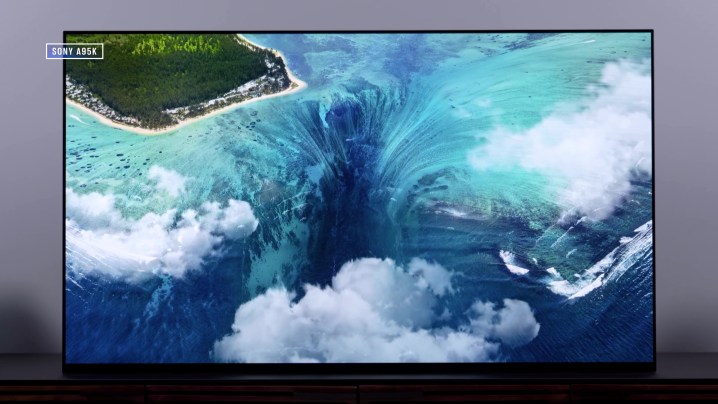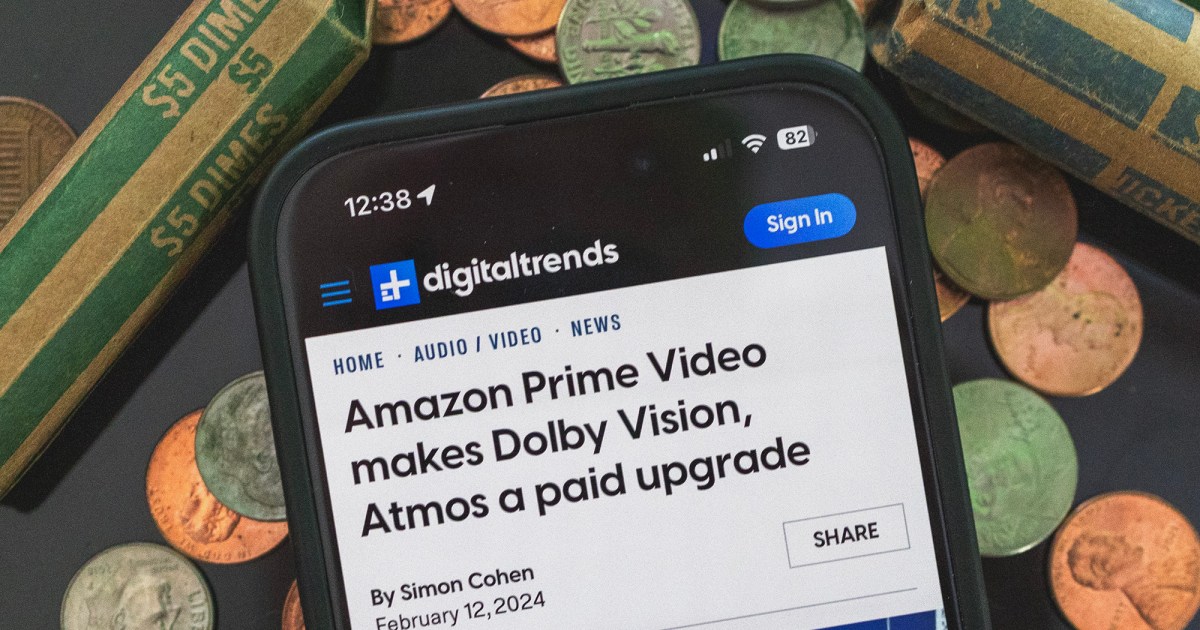
On right now’s episode of You Requested: Who else simply desires a giant, dumb TV? Can daylight injury your OLED TV? Why do TVs and displays look higher on the retailer than at residence? And, a recurring favourite: TV vs. PC monitor?
OLED shade

Sanders asks: As an proprietor of a Sony A95K, ought to I be apprehensive about direct daylight that may injury my TV over time? I learn some sources that stated this may very well be a factor on the whole for OLEDs. I’ve direct daylight hitting my TV for possibly two hours a day. I often shut my window blinds to be higher protected than sorry. But when I don’t have to, it might be even higher. Have a pleasant day.
You’ve a pleasant day, too! Have a pleasant, sunny day. However what about your OLED TV? How a lot sunbathing is OK for the A95K?
This one despatched me down an actual rabbit gap. Search this subject your self, and also you’ll see numerous people in boards and on information websites claiming that daylight does have an effect on OLED screens.
Sadly, no person is citing an precise supply for this data, so I began searching for scientific research. I discovered one particularly that confirmed that direct UV radiation was noticed to degrade the luminescence of OLED panels — however the paper was geared extra round the way to clear up this challenge than it was to explain in layman’s phrases what the precise situations of the research have been.
On Sony’s web site, it casually states, “Place the TV away from direct daylight. Daylight publicity can change the traits of your TV display screen and will seem as non-uniformity.” However, that might simply be Sony masking its tail.
Nonetheless, I’ve seen sufficient to consider that direct daylight publicity generally is a threat to an OLED TV. However … what sort of publicity? What sort of situations create that threat?
So far as I can inform, the injury is attributable to the warmth generated by solar publicity. Black supplies soak up extra gentle, thus changing extra of that gentle into warmth.
However what I don’t see mentioned is simply how direct that gentle must be. I additionally don’t see any details about whether or not it’s UVA or UVB gentle, or each, and I don’t see any information on how lengthy or repeated the publicity must be to trigger hurt.
I might take some consolation in realizing it was principally UVB gentle that causes the issue since residence home windows filter out most UVB gentle, however solely about 25% of UVA gentle.
So, yeah, there’s quite a bit I don’t know. However I do know it’s warmth that causes the difficulty, and I additionally know that the quantity of warmth that builds up will probably be instantly associated to how direct that daylight is. I’d be extra involved in case your TV is being instantly hit by daylight via the window, slightly than if the sunshine was simply spilling into the room via the window. If it’s excessive midday, that solar most likely isn’t shining instantly into the window. However relying on which path your window faces, and the way tall the homes or timber are in your space, I think about the A95K might get direct daylight when the solar is low on the horizon. If it truly is direct daylight, then I’d most likely draw the shades simply to be on the protected facet. However you may additionally attempt to gauge how a lot warmth is being generated by leaving the home windows open, and after about an hour of the solar publicity, go see how scorching that display screen is. If it’s fairly scorching, then it’s best to most likely simply not let the solar hit the display screen. If it actually isn’t even heat? I’d fear much less, however, once more, is it well worth the threat? I’ve to allow you to make that call.
Showroom shine

Shawn writes: In showrooms, there are all the time issues being performed on the shows. There, these movies look very lifelike. Every little thing is vibrant, clean, and colourful. However at residence, I haven’t been capable of recreate that. I take advantage of a Gigabyte M32U.
Might you clarify this a bit? What issues probably the most? Decision? Body price? Bit price? File format? Panel tech?
I’ve been listening to this query much more not too long ago. “It seemed so significantly better on the retailer! Why am I not seeing that at residence?” You’re asking a few monitor, I feel, however that is true for each displays and TVs.
I feel there are two elements at play right here. One is the lighting situations on the retailer paired with the settings on the TV or monitor. At most massive retailers, TVs and
These lighting situations are nothing like what most of us have in our houses. You may strive the Vivid image preset on the TV or the daytime mode on a monitor and see what you suppose, however I do know numerous people really feel like it’s too brash or harsh. That’s as a result of the TV turns into this tremendous scorching point-source of very blue gentle, and this wears our eyes out over time.
However most TVs additionally ship with a power-saving Eco mode turned on by default. That is how the TVs get by EU regulatory guidelines for energy consumption, and within the U.S., it’s how the TVs can get away with actually low energy price numbers on the Power Star labels. That eco or power-saving mode needs to be turned off for the TV to get anyplace near as shiny as what you noticed within the retailer.
So, your greatest transfer is to show off the eco mode. Typically that’s hidden within the TV or monitor’s menu (and never all the time underneath image settings), or underneath normal settings. And as soon as that’s carried out, decide an image mode preset that’s pleasing to you. These adjustments ought to make a dramatic distinction. Nevertheless, there’s one different issue.
Relying on the retailer you go to, it’s attainable they’re taking part in
Anyway, there are tons of attractive
It’s not just like the TVs and
Dumb TVs

Ralph from Scotland asks: What’s the level in me spending numerous money on, say, a 65- to 75-inch TV that I wish to final for the subsequent decade, however the place the software program will seemingly hardly ever be up to date, if ever? Would I not be higher off shopping for a very respectable low- or medium-price unit and counting on the heavy lifting being carried out by the dongle, which does get repeatedly up to date?
That does beg the query, is it attainable to get a very respectable big-screen TV which might be suited to this process?
We really feel you right here. We’ve talked about whether or not a dumb TV can be a wise thought, and heaps of oldsters like the thought of having the ability to purchase a dumb TV and simply depend on a streaming field or streaming stick that’s simpler to replace or exchange over time.
Nevertheless, as issues at the moment are, no person is making a dumb TV. Even the most affordable TVs now often have some form of good TV system in-built. As such, not a lot of the cash you’re spending goes towards that good TV system – all of them have it anyway. No, the extra you spend, the higher the image high quality ought to get.
The one platform that will get near permitting a “dumb TV” expertise is the Google TV platform. I suppose your greatest guess is to buy a TV that has Google TV, and from there, weigh your priorities. Which is extra vital? Measurement or image high quality? As a result of you may get a really massive TV for not a ton of cash. However that’s a really massive display screen with not-as-great image high quality. Or, you’ll be able to pour your funds into image high quality, however you’ll discover that you might have to go for a smaller display screen. I’m all the time encouraging people to search out the candy spot between measurement and movie high quality as a result of the TVs with actually nice image high quality at actually massive display screen sizes are likely to price a lot of cash. Additionally, because you need this TV to final, I’d direct a few of that cash into stable construct high quality, which often comes half and parcel with shopping for a higher-level TV.
TV vs. PC monitor

A YouTube viewer writes: My son desires so as to add a 48-inch TV in his pc room. He desires to observe films with a Fireplace Stick and play the Nintendo Swap. Ought to I purchase an OLED TV or a monitor? I want to future-proof and get him 120hz
I’d say that, if watching TV and taking part in Swap are the first makes use of for now, TV is the way in which, all day. TVs have superior image processors that make TV, films, and even YouTube movies look higher than they do on
Additionally, as a lot as I dump on how crappy TV audio system are, monitor audio system, in the event that they even have them, are often far worse. I don’t know, although, a mum or dad like you may also get them a sound system wherein case audio isn’t a priority.
The argument in favor of a PC monitor can be if the PC was the first supply — particularly in case your child goes to play numerous video games in an ultrawide 21:9 side ratio, or if they’re doing numerous productiveness work. Nonetheless, for those who’re taking a look at getting a 48-inch OLED TV, even with the letterbox bars on the high and backside of a 21:9 picture, that picture goes to be enormous. And, as I stated, if TV, films, and Swap are the first content material being seen, then a 16:9 TV display screen goes to be higher than having to cope with pillar field bars on the perimeters of the picture when utilizing an
So, a 48-inch OLED TV can be my alternative. An superior alternative, by the way in which. I’d advocate an LG C2 or C3. Or, heck, for those who wanna shoot for the moon and go for broke, take a look at the LG OLED Flex – it’s like a TV/monitor hybrid with RGB lighting and the flexibility to have a curved or flat display screen. I love that factor.
Editors’ Suggestions
Supply Hyperlink : z2658.com


